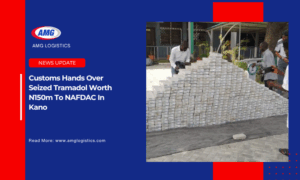Few days after hastily assuring that the controversial Cabotage Vessel Financing Fund (CVFF) is safe in the banks, the agency has again taken a step that further fueled speculations and anxiety about the status of the dedicated fund.
To the consternation of stakeholders, NIMASA in a public notice in some newspapers, requested for expression of interests from commercial banks for a part in the disbursement of the CVFF.
Titled: “Implementation And Disbursement Of The Cabotage Vessel Financing Fund (CVFF): Expression Of Interest As A Primary Lending Institution”, the advertorial requested that, interested “Deposit Money Banks (DMBS) duly licensed by the Central Bank of Nigeria (CBN); and Local and Foreign Development Financial Institutions (DFIs), to apply for accreditation as Primary Lending Institutions (“PLIS”) under the Cabotage Vessel Financing Fund (“CVFF” or the “Fund”)”.
Shipping Position Daily, however recalls that earlier last week, NIMASA hurriedly debunked news making the rounds about the CVFF.
The agency had in a statement issued on Tuesday clarified that, “funds accrued under the Cabotage Vessel Financing Fund are intact and currently held with the Central Bank of Nigeria (CBN) under the Single Treasury Account (TSA)”.
It said further that, “this is contrary to a misleading publication alleging that funds have disappeared from the CVFF account”.
The agency added that the report of a missing money is both misleading and false.
“For the record, the Cabotage Vessel Financing Fund, securely held in the NIMASA account at the Central Bank of Nigeria (CBN), remains intact. There has been no disappearance of funds, and no illegal transactions, as the article suggests.
This misinformation is a figment of the authors imagination, aimed at undermining NIMASA’s integrity, and mislead the public about the Agency’s operations”, the statement added.
The statement quoted its Director General; Dr Dayo Mobereola as assuring that “the Management of NIMASA will ensure that the CVFF is utilised in line with its statutory purpose”, even as it assured stakeholders of the safety of funds under the CVFF.
His words: “Let us be clear that the CVFF account at the Central Bank of Nigeria is safe, intact, and secure. We at NIMASA will continue to manage it with the utmost responsibility, and there are no irregularities or illegal activities surrounding the funds. I urge the public to disregard this false narrative and to continue trusting the Agency’s ability to uphold the integrity of Nigeria’s maritime sector”.
Recall that, the CVFF is a fund established under section 42 of the Coastal and Inland Shipping (Cabotage) Act 2003 to promote the development of indigenous ship acquisition capacity and to provide credit facilities to local maritime operators. It is payable by all ship owners under the Cabotage Act.
Even though interested stakeholders, especially, ship owners have variously expressed doubts about the whereabout of the controversial fund, and also expressed doubt about the sincerity of disbursement of the funds, NIMASA last Friday tactically announced the abortion of previous efforts to disburse the funds.
Some ship owners told our correspondents last weekend that, NIMASA has not demonstrated good faith in the handling of the CVFF accruals
Speaking anonymously, because of the sensitive nature of the matter, they pointedly accuse the Ministry of Marine and Blue Economy as well as NIMASA, of insincerity.
They made reference to the assurance given in May by the Minister; Mr Adegboyega Oyetola, at a meeting where he assured them that the CVFF would support the growth and development of the shipping business in the country.
He had said that the Ministry was committed to delivering the disbursement of the CVFF to enhance efficiency, transparency, and competitiveness in the sector.
“When and how is he going to do that, when they keep shifting the goal post, and cancelling every previous arrangements that were meant to lead to the disbursement of the CVFF. I am tempted to believe that the CVFF has been spent on other things, the money may not actually be there”, a top ship owner told our correspondent on Saturday.
The ship owner specifically made reference to the requirements that were published on Friday. He explained that, even though they were not significantly new, they were meant to begin another cumbersome process.
“Where do we start from again. We had met NIMASA on CVFF on several occasion, and we were assured that the funds would be disbursed. But we became suspicious when they started brining up funny excuses. The current management of NIMASA may have seen that the funds are not really there, or that it had been diverted. I doubt that the new efforts would lead anywhere”, he stated.
In the new advert, NIMASA stated that the banks that would qualify would work with the agency “to determine the Risk Acceptance Criteria for applicants in utilizing the CVFF via direct disbursements and/or by issuing guarantees”.
Additionally, the banks must provide counterpart financing for the specific transaction(s), in addition to adequately structure and secure the Joint Lenders’ (CVFF and the PLIS) exposure to beneficiaries.
In collaboration with NIMASA, the banks must show capacity in loan monitoring and management while ensuring, amongst other things, adequate and timely repayment of the credit facility extended.
The banks must also be ready to bear the entire credit risk of the transactions. In addition, the banks are required to: (a) Assess (with verifiable evidence) that the indigenous maritime operator, requesting funding under this scheme, can provide the minimum equity contribution of fifteen percent (15%) of the credit facility request; (b) Be committed to contribute a counterpart funding of a minimum of thirty-five percent (35%) of the credit facility request; and (c) Be committed to providing the counterpart funding at a Weighted Average Single Digit Interest Rate.
On these conditions, the ship owner lampooned NIMASA for recycling guidelines that have been in existence for many years and known to all stakeholders.





